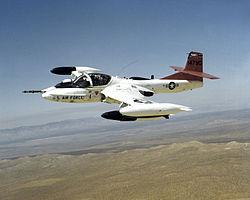Vietnam War
In August 1967, 25 A-37As were deployed to Vietnam under the "Combat Dragon" evaluation program, and flew from Bien Hoa Air Base on USAF "air commando" missions, including close air support, helicopter escort, FAC, and night interdiction.[10] Combat loads included high-explosive bombs, cluster munition dispensers, unguided rocket packs, napalm tanks, and the SUU-11/A Minigun pod.[3] For the majority of missions, the aircraft also carried two additional external fuel tanks on the inner stores pylons.
During this period, the A-37As flew thousands of sorties; none were lost to enemy fire, although two were wrecked in landing accidents. While the aircraft was formally named the "Dragonfly", many pilots called it the "Super Tweet". The Combat Dragon program was successful, but unsurprisingly the combat evaluation revealed some of the deficiencies of the A-37A.[11] The most noticeable problem was that the aircraft lacked range and endurance. Other concerns were heavy control response during attack runs (the flight controls were not power-boosted) and the vulnerability of the aircraft's non-redundant flight control system. Some pilots also criticised the machine gun as ineffective and negatively impacting the pilot's view.[12][13]

The USAF signed a contract with Cessna in early 1967 for an improved Super Tweet, designated the "A-37B". The initial order was for 57 aircraft, but this was quickly increased to 127; the unit cost of these aircraft were roughly one quarter of the McDonnell Douglas F-4 Phantom II all-weather fighter aircraft.[14] The A-37Bs were primarily intended to be supplied to the Republic of Vietnam Air Force (RVNAF) as replacements for their A-1 Skyraiders. The A-37B prototype was rolled out in September 1967, with deliveries to the South Vietnamese beginning in 1968.
The A-37Bs were all newly built airframes that were considerably stronger than those of the A-37A, capable of pulling six g instead of five, and were built to have a longer fatigue life of 4,000 hours. Field experience would demonstrate that 7,000 hours between overhauls could be tolerated. The A-37B weighed almost twice as much as the T-37C; a remarkable fraction of the loaded weight, 5,800 lb (2,600 kg), could be external stores. In practice, the A-37B usually operated with at least two and sometimes four underwing fuel tanks to improve combat endurance. The A-37B added a refueling probe to the nose, leading to pipes wrapped around the lower lip of the canopy, for probe-and-drogue aerial refueling. This was an unusual fit for USAF aircraft, which traditionally are configured for boom refueling. Other improvements included updated avionics, a redesigned instrument panel to make the aircraft easier to fly from either seat, an automatic engine inlet de-icing system, and revised landing gear. Like its predecessors, the A-37B was not pressurized.
In order to accommodate the increased weight, the A-37B was powered by General Electric J85-GE-17A engines, providing 2,850 lbf (12.7 kN) thrust each. These engines were canted slightly outward and downward to improve single-engine handling.[15] Air commando pilots in Vietnam operating the A-37A had found single-engine cruise an effective means of improving their flight endurance. Modifications were made to control surfaces to improve handling. To improve aircraft and crew survivability, the A-37B was fitted with redundant elevator control runs that were placed as far apart as possible. The ejection seats were armored, the cockpit was lined with nylon flak curtains, and foam-filled self-sealing fuel tanks were installed. To extend endurance, pilots were authorized to fly the A-37 on only one active engine, an uncommon practice outside of emergency situations at that time.[9]

The 20 mm (0.787 in) GPU-2/A and AMD 30 mm (1.18 in) cannon pods were tested with favorable results on the A-37B,[16] but reports indicate that such pods were either seldom or never used in operation.
The A-37 proved to excel at the close air support mission.[10] It was able to engage targets at speeds roughly 100 miles per hour slower than swept-wing fighters and by doing so improve its bombing accuracy; pilots were reportedly able to achieve an average accuracy of 45 feet (14 m). While the aircraft's slow speed was feared to make it more vulnerable to hostile ground fire, the A-37's relatively small size, atypical speeds, and relatively low altitudes combined to make it somewhat hard to effectively hit with gunfire.[10] The A-37 required a relatively low amount of maintenance compared to contemporary fighters—only two hours of maintenance for each hour of flight time, six times less than that of the McDonnell F-101 Voodoo; a feat was partially due to the convenient placement of multiple access panels at strategic locations.[17][18]
The A-37 did not typically attract attention from the media, unlike many other USAF combat aircraft used in the theatre; one reason for this was that the type was never flown into North Vietnam, where hostile air defenses were proved to be challenging, claiming to have downed almost 200 F-4s and 300 F-105s by the conflict's end. Instead, A-37s operated in the south, as well as in neighboring Laos and Cambodia, where it was typically used to support US ground forces.[9]
A total of 577 A-37Bs were constructed, 254 of which being delivered to the RVNAF. By the war's end, the A-37 had flown over 160,000 combat sorties, during which only 22 USAF aircraft were recorded as lost due to combat. The type remained active in the theatre right up until the Fall of Saigon, shortly prior to which efforts were made to retrieve as many as possible before they fell into North Vietnamese hands.[19] As a consequence of the North Vietnamese capture of Da Nang Air Base at the end of March 1975, their forces captured large amounts of stores and equipment, including 33 intact A-37s.[20][21] On 28 April 1975, several of these captured A-37s were used by the North Vietnamese to attack Tan Son Nhut Air Base, still held by the South Vietnamese.[22][23]
No comments:
Post a Comment